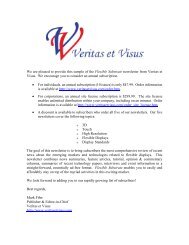You also want an ePaper? Increase the reach of your titles
YUMPU automatically turns print PDFs into web optimized ePapers that Google loves.
<strong>Veritas</strong> <strong>et</strong> <strong>Visus</strong> <strong>Display</strong> <strong>Standard</strong> February 2009<br />
The panel used for this evaluation was a 9.0inch<br />
diagonal field sequential color<br />
(852x480) LCD. The evaluated pictures and<br />
their color chromaticity measurement data<br />
are shown in Figure 1. The team selected 16<br />
pictures of objects or landscapes, which<br />
represent 13 chromatic and three achromatic<br />
colors, and prepared 49 pictures in various<br />
color chroma and hue at nearly the same<br />
brightness and luminance contrast. The<br />
evaluated pictures were displayed with the<br />
original color picture side-by-side on the<br />
screen. The subjects evaluated the color<br />
quality of each picture by comparing with<br />
the original image, and rated the allowable<br />
color difference using a scale of the<br />
following five levels: 1: very worrisome, 2:<br />
worrisome, 3: worrisome for a while but it is<br />
allowable, 4: hardly worrisome but it is<br />
optimal, 5: not worrisome at all.<br />
Figure 2 is a chromaticity diagram showing<br />
the area of optimal and allowable limits for<br />
chromatic colors. The area of each limit<br />
becomes wider with increase in chroma<br />
depth. The results of the deeper chroma<br />
pictures: b), d), e), g), i) and k) show that the<br />
color shift from the original to lighter<br />
chroma is less allowable than that to deeper<br />
chroma. The area of each limit for deep red,<br />
green and blue shows that a width for<br />
chroma direction is wider than that for the<br />
hue direction. On the other hand, in the area<br />
of cyan, magenta and yellow, the width for<br />
chroma direction is narrower than that for<br />
the hue direction. The color shift from white<br />
to yellow is less allowable than white to<br />
blue.<br />
The researchers suggest that to realize good<br />
viewing angle characteristics of color image<br />
of cyan, magenta and yellow, viewing angle<br />
characteristics of luminance contrast ratio<br />
should be made wider for small color<br />
chroma shift. In contrast, for color image of<br />
red, green and blue, the balance b<strong>et</strong>ween<br />
RGB gamut curves should be made<br />
correspond to every viewing angle for small<br />
color hue shift.<br />
Figure 1: Evaluated pictures and their original color<br />
chromaticity on CIE1976-UCS diagram<br />
Figure 2: Optimal and allowable limits for each chromatic color<br />
48






